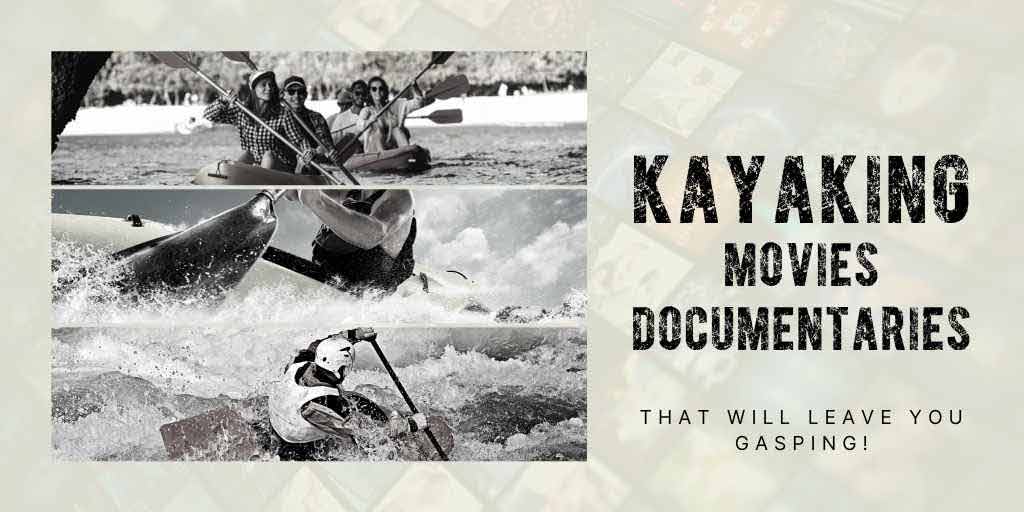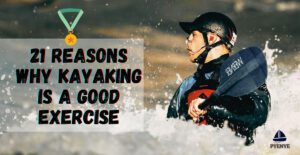From the heart-pumping thrill of shooting down roaring rapids to the peaceful tranquility of gliding across calm waters, kayaking offers an incredible range of experiences. And there’s no better way to immerse yourself in the sport than by watching these kayaking movies and documentaries.
Featuring some of the world’s most talented and daring kayakers, these films take you on a wild ride through some of the most stunning and remote waterways on the planet. You’ll witness the jaw-dropping beauty of cascading waterfalls, awe-inspiring canyons, and unspoiled wilderness areas.
But it’s not just about the scenery – these films also delve into the heart and soul of kayaking, exploring the mental and emotional challenges that come with pushing oneself to the limit.
So get ready to be inspired and captivated by the raw power and beauty of kayaking in all its forms.

Jump To A Section
The Best Kayaking Movies
For those who crave adventure and the rush of adrenaline, kayaking is an experience like no other. And when capturing the excitement and beauty of this exhilarating sport on film, few do it better than the movies on this list. We’ve scoured the globe to bring you the very best kayaking movies, each one a masterpiece of cinematography and storytelling.
From daring descents down raging whitewater rapids to tranquil journeys through pristine wilderness areas, these films offer a glimpse into the heart and soul of kayaking. You’ll witness the incredible skills and courage of the world’s top kayakers as they tackle some of the most challenging and awe-inspiring waterways on the planet.
“The River Wild” (1994)
“The River Wild” is a 1994 action-thriller film directed by Curtis Hanson, starring Meryl Streep, Kevin Bacon, and David Strathairn. The movie follows a family who embarks on a river-rafting vacation in Montana but soon finds themselves in a life-threatening situation when they encounter two dangerous criminals.
The kayaking scenes in “The River Wild” are some of the most thrilling and intense moments in the film. Meryl Streep’s character, Gail, is an experienced kayaker who leads her family on a whitewater rafting adventure down a wild and scenic river. The kayaking scenes are shot with incredible precision and detail, showcasing the power and beauty of the river and the skill and athleticism of the actors and stunt doubles.
The kayaking scenes are also significant to the plot, as Gail’s kayaking skills become essential in the family’s fight for survival against the two dangerous criminals they encounter on their journey. Gail must use her kayaking abilities to navigate dangerous rapids, avoid deadly obstacles, and outsmart the criminals who are pursuing them.
The impact of “The River Wild” can still be felt today, with the film serving as an inspiration for many modern action-adventure movies that feature kayaking and other extreme sports. Additionally, the film helped to popularize kayaking as a recreational activity, with many people inspired to try the sport for themselves after watching the movie.
“Kayak to Klemtu” (2018)
“Kayak to Klemtu” is a Canadian drama film that follows a young woman named Ella, who embarks on a kayaking journey along the rugged coast of British Columbia to fulfill her late uncle’s final wish. Along the way, she confronts the challenges of the journey and the complexities of her own family relationships.
The film begins with Ella’s uncle, a First Nations activist, passing away and leaving her with the task of spreading his ashes in his ancestral home of Klemtu. Ella sets out on her journey in a kayak, accompanied by her estranged aunt, cousin, and a family friend. Along the way, they encounter a series of obstacles, including treacherous waters and encounters with local fishermen.
As the group continues on their journey, they begin to confront the complicated family dynamics that have driven them apart. The film explores themes of reconciliation and the importance of family ties, as well as the struggles and triumphs of reconnecting with one’s cultural roots.
Beyond its emotional depth, “Kayak to Klemtu” is also a visually stunning film that showcases the natural beauty of the British Columbia coast. The film captures the awe-inspiring scenery of the Pacific Northwest, from towering mountains to pristine forests to the rugged coastline.
Overall, “Kayak to Klemtu” is a powerful and inspiring film that celebrates the beauty of nature and the importance of family ties. It offers a unique and compelling perspective on the human experience, exploring themes of reconciliation, identity, and cultural heritage. Whether you are a kayaking enthusiast or simply a lover of compelling storytelling, this film is not to be missed.
“Whitewater Summer” (1987)
“Whitewater Summer” is a coming-of-age adventure film released in 1987, directed by Jeff Bleckner and starring Kevin Bacon, Sean Astin, and Jonathan Ward.
This movie tells the story of a teenager named Alan (played by Sean Astin), who is sent to a wilderness camp to learn about survival skills and whitewater kayaking under the guidance of an experienced outdoorsman named Vic (played by Kevin Bacon).
Where at the beginning of the film, Alan is a shy and insecure teenager who lacks confidence and struggles to make friends. However, as he learns and masters the skills of whitewater kayaking, he gains a newfound sense of self-assurance and inner strength.
They showcase the beauty and excitement of whitewater kayaking while also highlighting the personal growth and development of the main character. As he navigates the rapids and hazards of the river, he learns to face his fears and overcome the obstacles that stand in his way.
The movie has become a cult classic among fans of outdoor adventure films and is still enjoyed by audiences today.
“Chasing Niagara” (2016)
“Chasing Niagara” was released in 2016. The movie follows the journey of kayaker Rafa Ortiz as he attempts to conquer Niagara Falls, one of the most dangerous and legendary rapids in the world.
The film begins by introducing Rafa Ortiz and his passion for kayaking. The audience learns about his background and his experiences as a professional kayaker, including his desire to push himself beyond his limits and take on increasingly difficult challenges.
As Rafa prepares to tackle Niagara Falls, the film takes the audience on a journey through his training process and his attempts to master the rapids leading up to the main event. Along the way, the film showcases the stunning beauty of the natural environments where Rafa practices and competes, including rivers in Mexico and other parts of the world.
As the day of the Niagara Falls descent approaches, the film builds tension and excitement, documenting Rafa’s meticulous preparation and the challenges he faces both physically and mentally. Finally, the audience witnesses Rafa’s attempt to conquer the falls, which becomes a harrowing and heart-pumping battle between man and nature.
Beyond the thrilling action sequences, “Chasing Niagara” also explores deeper themes related to personal passion and perseverance. The film highlights the importance of following one’s dreams, no matter how difficult or dangerous they may seem, and the rewards that come from overcoming obstacles and pursuing one’s true calling.
All in all, Chasing Niagara is an inspiring film that has had a tremendous impact on the world of whitewater kayaking and adventure sports in general. It has encouraged countless people to try their hand at extreme activities while also helping foster greater understanding amongst those who already enjoy them.
Paddleton (2019)
“Paddleton” is a 2019 American independent film directed by Alex Lehmann and starring Ray Romano and Mark Duplass. The film follows the story of two middle-aged neighbors who bond over their love of playing a game called Paddleton, a hybrid of paddleball and volleyball, and their journey as one of them is diagnosed with terminal cancer.
This movie explores themes of mortality, friendship, and the importance of human connection. It shows how people can find solace and support in each other during difficult times and how the simple joys of life, such as playing a game or sharing a meal, can bring people together and provide comfort.
Moreover, the film also sheds light on the challenges faced by individuals diagnosed with terminal illnesses and their caregivers and highlights the importance of empathy and understanding in such situations. It depicts the emotional and physical toll that such illnesses can have on the patient as well as their loved ones and the ways in which they cope with it.
“The Weight of Water” (2001)
“The Weight of Water” is a 2001 American drama film directed by Kathryn Bigelow and based on the novel of the same name by Anita Shreve. The film tells the parallel stories of two women who lived a century apart: a contemporary photographer investigating a 19th-century murder case while on a kayaking trip with her husband and a group of friends and the events leading up to the murder itself.
The film portrays the interplay between past and present as the modern-day characters uncover and confront the secrets of the past, which have a profound impact on their own lives and relationships.
Moreover, the film also sheds light on the complexities of human relationships as the characters grapple with issues of trust, jealousy, and betrayal. It shows how the events of the past can reverberate through time and affect the lives of those in the present and how the choices we make can have a lasting impact on ourselves and others.
Furthermore, the film also highlights the power of storytelling and the role of the narrator in shaping our understanding of events and characters. It shows how the stories we tell ourselves and others can shape our perceptions of reality and influence our actions.
The Best Kayaking Documentaries
For those who love kayaking or are simply fascinated by the sport, there are a variety of documentaries that showcase the beauty and power of this incredible activity.
Now let’s explore some of the best kayaking documentaries that capture the essence of this incredible sport and take you on a journey through some of the most breathtaking landscapes on the planet.
“Liquid Logic” (2008)
“Liquid Logic” is a kayaking documentary that was released in 2008. It follows a group of world-class kayakers as they travel around the world in search of the best rivers to paddle. The film showcases their incredible skills and the beautiful and often treacherous natural environments they navigate.
The film begins by introducing the kayakers and their various backgrounds and motivations for pursuing this extreme sport. It then takes the audience on a journey through different countries, including Mexico, Norway, and Canada, as the kayakers tackle some of the most challenging rivers in the world.
Throughout the film, the kayakers showcase their technical abilities and their courage in the face of danger. They are shown navigating narrow gorges, steep waterfalls, and fast-moving rapids, often in locations that are remote and difficult to access. The film also highlights the camaraderie and mutual support among the kayakers, who work together to achieve their goals and keep each other safe.
Beyond the breathtaking visuals and thrilling action sequences, “Liquid Logic” also explores the deeper significance of kayaking and extreme sports in general. The film touches on themes such as the connection between humans and nature, the pursuit of personal growth and self-discovery, and the importance of pushing oneself beyond one’s limits.
“Kayaking the Aleutians” (2015)
Kayaking the Aleutians is an incredible 2015 kayaking movie that showcases the beauty and adventure of paddling through the remote Aleutian Islands. It provides a unique insight into this little-known part of the world and emphasizes the importance of conservation and preserving its natural beauty.
The Aleutians are a chain of islands stretching from Alaska to Russia and have long been home to indigenous people living a traditional lifestyle. The movie follows four professional kayakers as they travel through these islands and explore their culture. During their adventure, they encounter some of the most stunning landscapes in North America – from snow-covered peaks to crystal blue waters surrounded by lush green vegetation. They also meet local communities who share stories about their lives, struggles, and hopes for the future.
The movie emphasizes how important it is to respect nature and its inhabitants when traveling in such remote areas. In one scene, the crew encounters a brown bear on their journey, prompting them to pause and admire its beauty before leaving it in peace. This scene serves as a reminder that humans are not always at the top of the food chain in these places – even though we may feel like we are because of our technological advances – but rather should strive to coexist with nature’s true masters.
Aside from showcasing some amazing scenery and emphasizing conservation, Kayaking The Aleutians also shed light on an otherwise unknown corner of our planet. For many viewers, this will be their first glimpse into this fascinating part of North America, providing an insight into what life is like amongst some of its most isolated populations. Indeed, this movie holds great educational value for people interested in exploring less-traveled destinations around the world – whether on land or water!
“Into the Tsangpo Gorge” (2002)
The 2002 kayaking movie Into the Tsangpo Gorge has become a classic in the outdoor adventure community. The movie follows a group of intrepid kayakers as they journey down the Tsangpo River in Tibet, one of the most dangerous and remote rivers in the world.
Along the way, they face treacherous rapids, snow-capped mountains, raging waterfalls, and some of the most extreme whitewater ever documented on film. At its core, Into the Tsangpo Gorge is an exploration of human courage and determination. The kayakers are pushed to their limits as they bravely navigate some of nature’s greatest obstacles.
As their journey progresses, it becomes clear that their success is not just a matter of skill or physical strength—it is also about having faith in each other and believing that anything is possible. This message resonates with viewers long after they have watched the film and has been key to its continued success over two decades later.
In addition to being an incredible adventure story, Into the Tsangpo Gorge is also a testament to how far human beings are capable of pushing themselves when faced with adversity. The kayakers’ willingness to take on such a treacherous feat demonstrates both their commitment and their passion for exploring new frontiers. It also reflects upon our collective ability to pursue ambitious goals even when we know that failure may be near certain.
For many viewers, Into the Tsangpo Gorge stands as one of the best examples of outdoor filmmaking ever produced. Its stunning visuals capture both the beauty and peril of this natural wonderland, while its characters provide an inspiring reminder that with enough heart and determination, anything can be achieved. It’s no wonder why this classic film continues to capture people’s imaginations over twenty years later!
In conclusion, kayaking movies and documentaries have the power to inspire adventure and ignite a sense of curiosity and wonder in their audiences. These films showcase some of the most beautiful and challenging waterways in the world, from the whitewater rapids of the Grand Canyon to the remote and rugged Aleutian Islands. By sharing the stories of kayakers who have pushed the boundaries of what is possible, these movies encourage viewers to step outside their comfort zones and explore the natural world.
At their core, kayaking movies and documentaries are about more than just the thrill of the ride. They also explore deeper themes related to perseverance, teamwork, and human connection, highlighting the importance of personal growth and community in the pursuit of adventure. Whether you are an experienced kayaker or a newcomer to the sport, these films offer a unique and inspiring perspective on what it means to push yourself to the limit and embrace the unknown.


